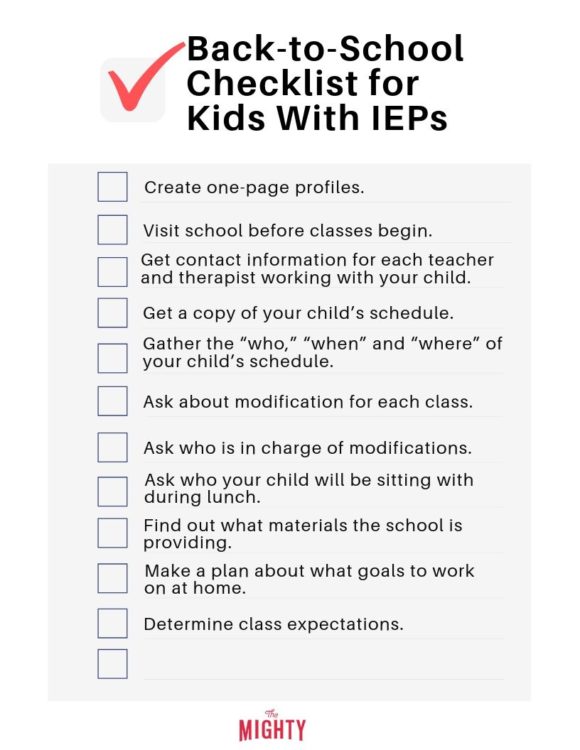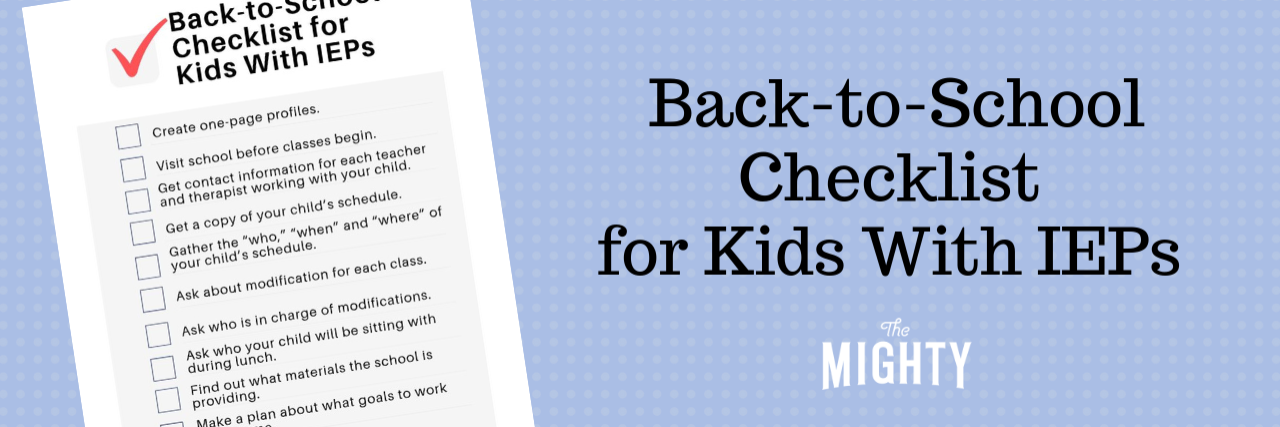My youngest daughter has Down syndrome and she starts middle school in about a week. I’ve never been more anxious and scared about school!
I already like her special education teacher. I believe she is going to push my daughter more than other teachers have in previous years because she believes in her potential. But my daughter will also be in some general education classes, going from class to class and taking the bus for the first time in her schooling days.
I always prepare for the new school year, but this year I am taking it up a notch. I should add I already have another middle schooler with an IEP, but she can tell me what happens at school, if someone is bullying her or if a teacher is not following her IEP — something my daughter with Down syndrome cannot. I created a checklist to make sure I have all my “ducks in a row” and I hope this is helpful for you too. I even made a PDF so you can download it and keep it handy during your IEP meetings.

1. Create one-page profiles.
These are a must-have. Not all teachers read the IEP (so problematic) so this is the “IEP Lite” version they need. I make them for each teacher my kids have. You can create one too using this easy template.
2. Set up a time to visit school before classes begin.
Most schools usually have an open house for students to find their lockers and classes, meet their teachers and get their schedules. These are great, but they don’t work well for my two kids with disabilities who need one-on-one time with teachers and an opportunity to ask questions and get acquainted without the overwhelming sensory experience of an open-house.
3. Get contact information for each teacher and therapist working with your child.
I ask for names, emails, extension numbers (if they have them), best way to contact them and how long it takes for them to respond. I also ask them for a favorite candy bar or drink and send them as “small gifts” throughout the year.
4. Get a copy of your child’s schedule.
I like to get a copy of my child’s schedule ahead of time and I have it in a visible place at home. If anything comes up I can see at a glance where my child is supposed to be at and I can follow up if, let’s say, my child is spending more time in the special education classroom than is specified in her IEP. It has happened a few times…
5. Gather the who, when and where of your child’s schedule.
I learned I have to be very specific about my child’s schedule to get answers. My daughter doesn’t have a one-on-one paraprofessional, so her aides change throughout the day. I need to know who is with her and when. I need to know when she is being pulled out for speech, who is taking her and where in the building they are going. Those details are so important.
6. Ask about modifications for each class.
I wish I started doing this earlier and was more proactive about it. My child needs modifications, and not just a stool by her feet because she is shorter and needs that support. She needs curriculum modified so that it is accessible to her and so she can learn the material/concepts. The reality is, not every child has modifications or adaptations set in place by the time school begins… or at all. This should never happen.
7. Ask who is in charge of modifications.
Chances are the special education teacher is in charge of modifying curriculum for each class. (Shout out to special education teachers who have to do this for every general education class each of their students are in.) However, general education teachers are responsible for making sure these modifications are happening when the student is in their class. Bring this up before school begins because these modifications should be set up by the first day of school.
8. Ask who your child will be sitting with during lunch.
It may sound silly, but lunch is kind of a big deal. Who our kids sit with should be their choice. There are schools that sit all special education students together during lunch, automatically excluding them from their peers during one of the most social times during the school day (especially for middle school and high school students). Some students do prefer to sit together, and if it is their choice, I am all for it, but this is a great opportunity to work on some of those social skills and interact with their “typical” peers. If your child has a good friend they like to sit with during lunch, make sure the teachers/aides know. With busy school cafeterias, they may need help finding their safe friend.
9. Find out what materials the school is providing.
Most school-supplies lists include things like pencils and scissors. For my kids, some of these tools need to be adaptive. For example, my daughter needed adaptive scissors for a while, and even now both my girls benefit from “chunky” pencils and notebooks with different lining. I found out several years ago that school provides some of these adaptive materials for our kids.
10. Make a plan about what goals to work on at home.
I have to ask for my child to get homework every single year. Just because she has an IEP doesn’t mean she shouldn’t be creating the habit of working on skills or goals. I want her to learn that she has to work on those skills and then show her work. It is a helpful skill as I expect her to be as independent as possible and be able to keep a job. Training starts now. Some skills may be related to speech, practice her reading or creating presentations. Her sisters have homework, she should too.
11. Determine class expectations.
If all kids need to give a presentation about the novel they read, I am a firm believer my kid should do the best she can to do the same. Maybe she reads a different book, but she should also be given the opportunity to give a presentation.
What would you add?
Here are other posts that may help you get ready for this upcoming year:

